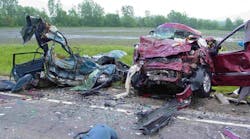Last week, the National Highway Traffic Safety Administration (NHTSA) the latest step in its research efforts to develop technology that would make motor vehicles inoperative if drivers are determined to be impaired by alcohol – technology that is being aimed at commercial fleets as well.
This latest prototype is the result of Driver Alcohol Detection System for Safety (DADSS) research being conducted by NHTSA and an “industry consortium” of companies.
“DADSS has enormous potential to prevent drunk driving in specific populations such as teen drivers and commercial fleets,” noted NHTSA Administrator Mark Rosekind in a statement during the event at DIT headquarters. “[It can also] be an option available to vehicle owners that would provide a powerful new tool in the battle against drunk driving deaths.”
From my perspective, at least, trucking fleets should welcome NHTSA’s ongoing technological focus (they’ve been at this for seven years now, since 2008) on what I prefer to refer to as “impaired driving,” because just labeling it “drunk driving” leaves out “drugged driving” in the minds of a lot of folks.
For starters, NHTSA’s own research shows that truck drivers are some of the most sober vehicle operators on our roads – you can click here to read more about that finding.So by and large, the technology being studied will be most effective in short-circuiting impaired driving by everyday motorists – the folks responsible for triggering the majority of truck-car crashes in the first place.
More importantly, though, this research directly addresses the biggest ongoing cause of highway crash deaths and injuries in the U.S. Look at NHTSA’s 2013 highway fatality data, for example: out of the 32,719 people killed in vehicle crashes that year, some 31% – over 10,000 of them – died as a result of impaired driving.
Even more disturbing, in 24% of those impaired driving fatality cases, the license of the impaired driver had previously either been suspended or revoked due to drunk and/or drug driving offenses.
By the way, those 10,000-plus deaths are over twice the number of folks killed in large truck involved crashes; a number pegged at 3,964 in 2013, according to NHTSA’s data.
So if a truly “autonomous” system can be developed that will lock down a vehicle if it detects that the driver is under the influence of alcohol or drugs, it could be a real game changer in terms of highway safety.
That’s especially true in one of the more bizarre cases involving trucking in recent memory when the U.S. Equal Employment Opportunity Commission (EEOC) sued Old Dominion Freight Line (ODFL) for violating the Americans with Disabilities Act when the carrier took a driver off the road who self-reported an alcohol problem. (You can read more about this strange story here.)Thus it might be nice to have such driver detection technology handy if carriers can actually be forced to put folks with alcohol or drug problems back behind the wheel.
And it’s important not to ignore the “drug use” part of that statement because, according to two studies released by NHTSA back in February, the use of marijuana and prescription drugs is becoming increasingly prominent on the highways – creating a whole new tangle of safety questions, NHTSA’s Rosekind (seen at left) noted at the time.
One study, the latest version of NHTSA’s Roadside Survey of Alcohol and Drug Use by Drivers, found that the number of drivers with alcohol in their system has declined by nearly one-third since 2007 and by more than three-quarters since the first Roadside Survey in 1973.
Yet that same survey found a large increase in the number of drivers using marijuana or other illegal drugs. However, in the 2014 survey, nearly one in four drivers tested positive for at least one drug that could affect the ability of drivers to operate vehicles safely on our roadways.
Ponder these numbers for a moment: The number of weekend nighttime drivers with evidence of drugs in their system climbed from 16.3% in 2007 to 20% in 2014, NHTSA found, while the number of drivers with marijuana in their system grew by nearly 50%.
A second NHTSA survey assessed whether marijuana use by drivers is associated with greater risk of crashes and found (unsurprisingly, at least from where I sit) that marijuana users are more likely to be involved in accidents – thought may be due in part because marijuana users are more likely to be in groups at higher risk of crashes. In particular, marijuana users are more likely to be young men – a group already at high risk.
The agency noted that this is one of the most precisely controlled study of its kind yet conducted, but it measured the risk associated with marijuana at the levels found among drivers in a large community.
Just goes to show that a lot of work still needs to be done to get impaired drivers off the road.





